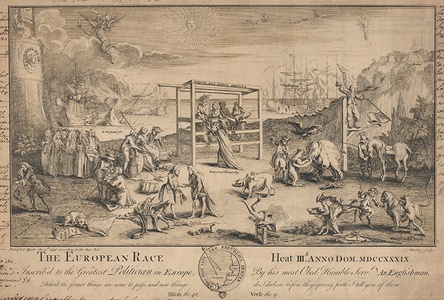| Method | Etching |
| Artist | Charles Mosley after Gravelot |
| Published | Publish'd April the 9th 1739 according to the late Act. C. Mosley Sculp. |
| Dimensions | Image 260 x 375 mm, Sheet 275 x 400 mm |
| Notes |
European political and colonial ambitions and conflicts satirised in the lead up to the outbreak in October 1739 of the War of Jenkins' Ear. Attempts to avoid the war, an Anglo-Spanish conflict that by the following year had become part of the much larger pan-European War of the Austrian Succession, had been the main impetus of the unsuccessful Convention of El Prado, which was signed by representatives of Britain and Spain in January 1739. The terms of the Convention were heavily criticised by the Tory Opposition, who saw them as emblematic of the inaction of the Prime Minister Robert Walpole. Other vociferous criticisms came from British merchants engaged in the slave trade under the Spanish Asiento de Negros, who were incensed by the enforcement of Spanish rights to search British vessels for contraband. The terms of the Asiento left little profit from the trade in slaves directly, so smuggling goods to Spanish America became the primary source of income for the British South Sea Company. Among other things the Convention also sought to determine borders for British Georgia and Spanish Florida. The current illustration is 'Heat 3' in a series of etchings representing the 'European Race' for colonial supremacy. In the centre of the scene, the judges, personifications of the continents, award a victors crown, a scimitar, a tusk of ivory, and a cornucopia of gold coins to the victor, France, wearing a cardinals hat and entitled 'Universal Monarchy.' Beside the scaffold, Britannia sits dejected upon a brace of cannon, her pockets picked by a Frenchman and a Spaniard. In the background, the Spanish armada is in flames near a tower blazoned with the bust of Queen Elizabeth and a George's flag bearing the motto 'In Hoc Signo Vinces' - in this sign, you shall conquer. In an illustration of how far the British navy has fallen, this historic victory is here labelled ominously 'to be paid for.' Above the scene the devil flies in glee. Below a team of London aldermen present a petition on behalf of the merchants, while the British agent at the Convention, Sir Benjamin Keene, has the terms rammed down his throat. Trade flees the scene weeping, dropping his hat, beside a dejected British bulldog, who lies on a carpet. A dragon carries a basket of Gazetteers past a pair of ambassadors sealing a union between the Bourbon monarchy and Austria, while the Dutch ambassador, having left his porcine mount to rootle about, is fired out of a mortar. To the right of the scene, the various national animals squabble. The Russian bear claws the trunk of the Turkish elephant, while a Frenchman prods the bear with a fleur-de-lys topped poker. The Imperial eagle watches the conflict from above. In the bottom right corner, the British lion, cowed and bridled, 'whelp'd in the Tower,' is mounted by the French fox, while an ape holds the reigns. The ape himself is kicked by the Spanish wolf, whose rider rubs him down with two bales of straw. Finally, a British royal courier serves his horse a bumper of wine in the name of 'Liberty,' while a young tar standing on a signpost waves a flag 'Pro Patria' and declares his opposition to Spanish naval privilege by shouting 'No Search.' In the distance, the flag of St George flies above the fort of Port Mahon, while rats scurry aboard a flotilla of warships. In the sky, an eclipse is about to take place, a comet blazes a path, and a pair of birds fly, the hindmost, carrying a banner of 'No Treaty' hot on the tail of its fellow, who drags a banner of 'Convention.' Charles Mosley (c.1720-1756) was a British engraver and occasional designer of book illustrations and satirical prints. He worked at The King's Arms and Key, Fleet Street (1738), Round Court in the Strand (1745), and Maiden Lane, Covent Garden. His stock in trade sold after his death at Prestage (1756). Gravelot was the pseudonym of the French engraver, designer, and book illustrator Hubert-François Bourguignon (1699-1773). A prolific engraver, Gravelot's most successful period came during his time in London between 1732 and 1745. His plates for Picart's Ceremonies and Religious Customs were particularly well-received, earning the praise of George Vertue, one of the most eminent engravers of the era. Condition: Trimmed within plate and laid to album page. Copious marginal annotations in old hand to all edges of sheet. Minor time toning, creasing, and foxing to sheet. |
| Framing | unmounted |
| Price | £350.00 |
| Stock ID | 53350 |

